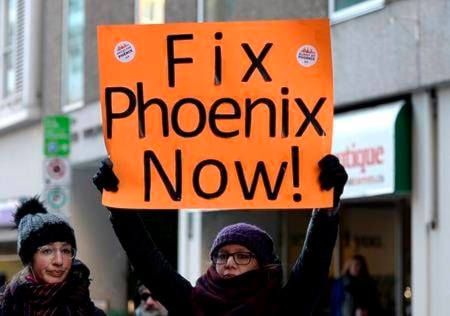The federal team charged with finding a replacement for the government’s troubled Phoenix pay system will present the Liberals with options within weeks that are expected to include “multiple pilot projects,” government officials say.
The plan could pit at least two of the three potential bidders on the projects against each other in a competition to see which system works better, either independently or in tandem with one another.
READ MORE: Replacing Phoenix pay system cheaper than fixing its mess, PBO reports
“In the coming weeks, the next-generation team will present options to the government for next steps, which will likely include multiple pilot projects to test possible solutions beginning later this year,” Treasury Board spokesman Farees Nathoo told The Canadian Press in an email.
The proposal is laying bare divisions among the unions representing the roughly 300,000 federal employees who have been living under the Phoenix pay cloud for more than three years.
One of those unions, the Public Service Alliance of Canada, says the move is wrongheaded and could result in another bungled pay system.
Testing separate pay systems through individual government departments, or in groups of departments, could produce problems for federal employees similar to those being experienced under the current, flawed system, warns PSAC national president Chris Aylward.
“That is very concerning because they have no clue about the way forward,” Aylward said.
When issues began to surface shortly after the IBM-built Phoenix pay system was launched in 2016, the government initially, in part, blamed the problems on segregated, antiquated departmental human resources systems that were incapable of properly communicating with each other and the Phoenix system, he noted.
“It concerns me if they say, ‘We don’t know how many providers we are going to use, we may have to use more than one,’” said Aylward.
“It sounds like we’re starting Phoenix all over again…. They need a system that works. One pay system that works for all 300,000 employees that currently get paid out of Phoenix.”
The Professional Institute of the Public Service of Canada, which represents about 60,000 of those employees and has been working closely with the government to find a new pay solution, doesn’t share PSAC’s concerns.
“I think that, so long as those are compatible systems and they are connected through some sort of internal cloud, then there shouldn’t be a problem between systems,” said union president Debi Daviau.
“But at this point we’re just trying to determine what is going to be the best system.”
Daviau suggested a pilot project at the Canada Revenue Agency, for example, could see about 50,000 people properly paid within a year, as opposed to implementing an entirely new software product, which could take several years.
PSAC, which represents the vast majority of federal workers, recently rejected an agreement supported by 13 other unions that will see federal employees who’ve been impacted by the failures of Phoenix provided an extra five days of paid leave over four years.
It has also walked away from contract talks with Treasury Board affecting more than 100,000 workers, turning down proposed pay increases amounting to 1.5 per cent annually.
The government last week invited “qualified respondents” to submit proposals to enter a third stage for developing a new HR and payroll system to replace Phoenix, after narrowing the field of potential bidders to three companies: Ceridian, SAP and Workday.
Bob Conlin, the public services lead in Canada for Germany-based SAP, suggested the government should tread carefully if it ultimately decides to contract more than one system provider and test their programs in different departments.
SAP already provides human resources systems for the Canada Revenue Agency and the Customs and Border Services Agency.
Those departments would benefit more from combining HR and payroll services under an existing service provider, said Conlin.
“If they were to extend (HR) with payroll, it would not be a Herculean leap for them,” he said in an interview.
“They would benefit in a big way from the opportunity to upgrade to modern technology.”
But Conlin cautioned that CRA, CBSA and the Department of National Defence, in particular, must be treated carefully.
“Those are some of the clients that absolutely have to get done right,” he said. “They are also some of the more complex civil service pay environments.”
On Thursday, the Parliamentary Budget Office told the House of Commons the government could expect to pay about $57 million dollars to buy, test and implement a new pay system. The price tag did not include annual operating costs estimated to reach almost $106 million.
The PBO also estimated it will cost taxpayers $2.6 billion to stabilize the existing pay system until a new one is fully adopted.
The former Conservative government had estimated Phoenix would save $70 million annually.
Terry Pedwell, The Canadian Press
